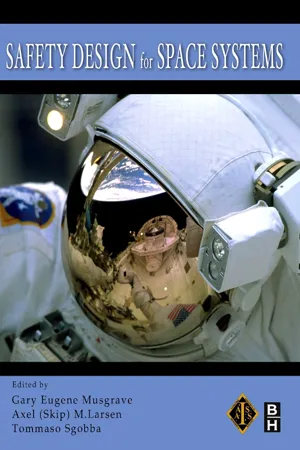
Safety Design for Space Systems
- 992 pages
- English
- ePUB (mobile friendly)
- Available on iOS & Android
Safety Design for Space Systems
About this book
Progress in space safety lies in the acceptance of safety design and engineering as an integral part of the design and implementation process for new space systems. Safety must be seen as the principle design driver of utmost importance from the outset of the design process, which is only achieved through a culture change that moves all stakeholders toward front-end loaded safety concepts. This approach entails a common understanding and mastering of basic principles of safety design for space systems at all levels of the program organisation. Fully supported by the International Association for the Advancement of Space Safety (IAASS), written by the leading figures in the industry, with frontline experience from projects ranging from the Apollo missions, Skylab, the Space Shuttle and the International Space Station, this book provides a comprehensive reference for aerospace engineers in industry. It addresses each of the key elements that impact on space systems safety, including: the space environment (natural and induced); human physiology in space; human rating factors; emergency capabilities; launch propellants and oxidizer systems; life support systems; battery and fuel cell safety; nuclear power generators (NPG) safety; habitat activities; fire protection; safety-critical software development; collision avoidance systems design; operations and on-orbit maintenance.- The only comprehensive space systems safety reference, its must-have status within space agencies and suppliers, technical and aerospace libraries is practically guaranteed- Written by the leading figures in the industry from NASA, ESA, JAXA, (et cetera), with frontline experience from projects ranging from the Apollo missions, Skylab, the Space Shuttle, small and large satellite systems, and the International Space Station- Superb quality information for engineers, programme managers, suppliers and aerospace technologists; fully supported by the IAASS (International Association for the Advancement of Space Safety)
Frequently asked questions
- Essential is ideal for learners and professionals who enjoy exploring a wide range of subjects. Access the Essential Library with 800,000+ trusted titles and best-sellers across business, personal growth, and the humanities. Includes unlimited reading time and Standard Read Aloud voice.
- Complete: Perfect for advanced learners and researchers needing full, unrestricted access. Unlock 1.4M+ books across hundreds of subjects, including academic and specialized titles. The Complete Plan also includes advanced features like Premium Read Aloud and Research Assistant.
Please note we cannot support devices running on iOS 13 and Android 7 or earlier. Learn more about using the app.
Information
Table of contents
- Cover image
- Table of Contents
- Copyright
- Preface
- Introduction
- About the Editors
- About the Contributors
- Chapter 1. Introduction to Space Safety
- Chapter 2. The Space Environment
- Chapter 3. Overview of Bioastronautics
- Chapter 4. Basic Principles of Space Safety
- Chapter 5. Human Rating Concepts
- Chapter 6. Life Support Systems Safety
- Chapter 7. Emergency Systems
- Chapter 8. Collision Avoidance Systems
- Chapter 9. Robotic Systems Safety
- Chapter 10. Meteoroid and Debris Protection
- Chapter 11. Noise Control Design
- Chapter 12. Materials Safety
- Chapter 13. Oxygen Systems Safety
- Chapter 14. Avionics Safety
- Chapter 15. Software System Safety
- Chapter 16. Battery Safety
- Chapter 17. Mechanical Systems Safety
- Chapter 18. Containment of Hazardous Materials
- Chapter 19. Failure Tolerance Design
- Chapter 20. Propellant Systems Safety
- Chapter 21. Pyrotechnic Safety
- Chapter 22. Extravehicular Activity Safety
- Chapter 23. Emergency, Caution, and Warning System
- Chapter 24. Laser Safety
- Chapter 25. Crew Training Safety
- Chapter 26. Safety Considerations for the Ground Environment
- Chapter 27. Fire Safety
- Chapter 28. Safe Without Services Design
- Chapter 29. Probabilistic Risk Assessment with Emphasis on Design
- Index